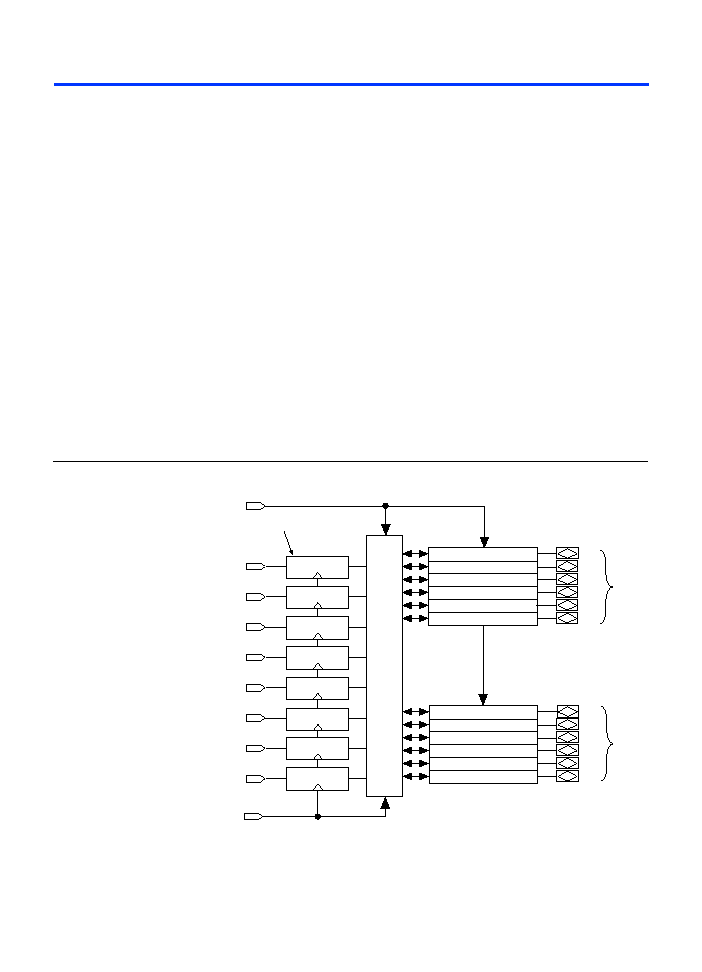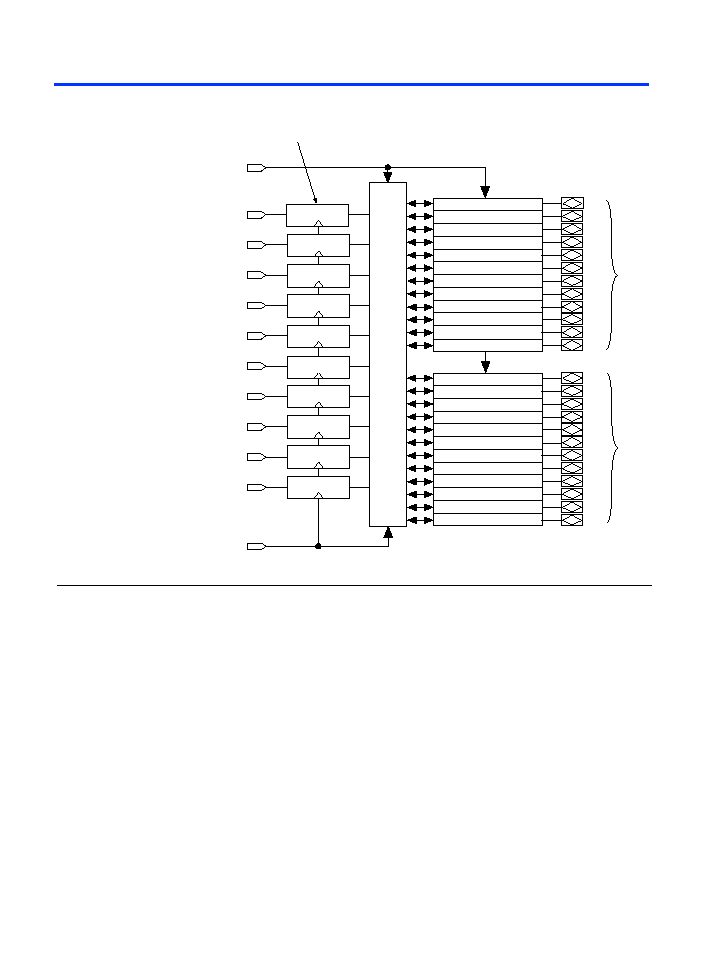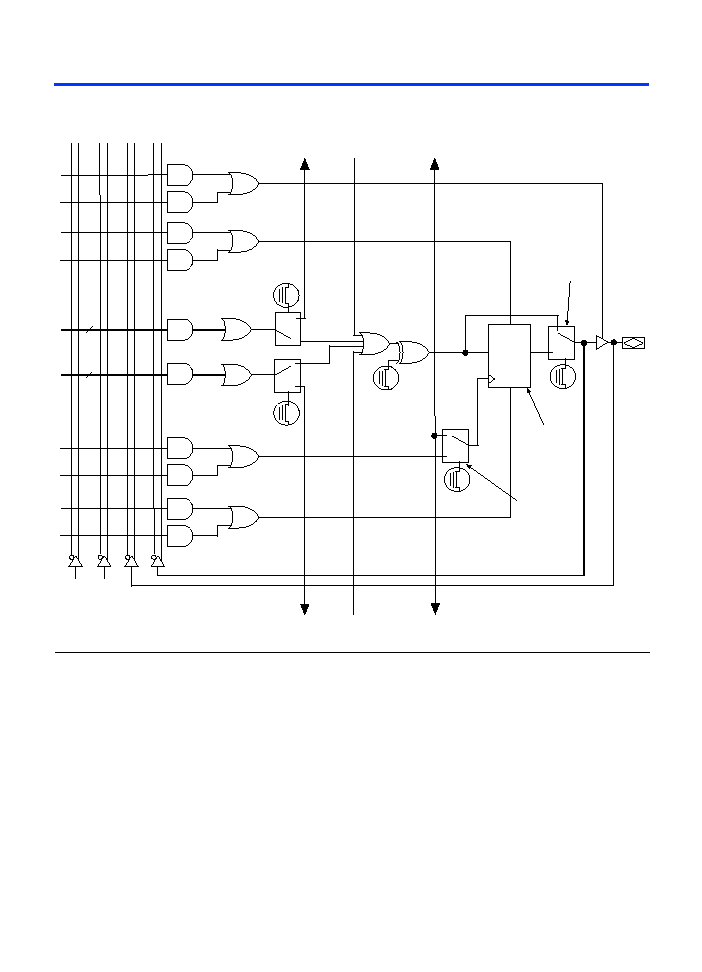
Æ
Altera Corporation
1
EP312 & EP324
Classic EPLDs
April 1995, ver. 1
Data Sheet
A-DS-312/324.01
Features
s
High-performance EPLDs with 12 macrocells (EP312) or 24
macrocells (EP324)
≠
Combinatorial speeds as fast as 25 ns
≠
Counter frequencies of up to 33.3 MHz
≠
Pipelined data rates of up to 66 MHz
s
Multiple 20-pin PAL and GAL replacement and integration
s
Device erasure and reprogramming with advanced, nonvolatile
EPROM configuration elements
s
Programmable registers providing D, T, JK, and SR flipflops with
individual Clear and Clock controls
s
Dual feedback on all macrocells for implementing buried registers
with bidirectional I/O
s
Programmable-
AND
/allocatable-
OR
structure allowing up to 16
product terms per macrocell
s
Two product terms on all macrocell control signals
s
Programmable inputs (8 in EP312, 10 in EP324) configurable as
latches, registers, or flow-through input
s
Available in windowed ceramic and one-time-programmable (OTP)
plastic packages with 24 to 44 pins:
≠
24-pin ceramic and plastic dual in-line package (CerDIP and
PDIP)
≠
28-pin plastic J-lead chip carrier (PLCC)
≠
40-pin CerDIP and PDIP
≠
44-pin PLCC
s
One global Clock pin; one global Input Latch Enable/Input
Clock/Input (
ILE
/
ICLK
/
INPUT
) pin
s
Programmable "standby" option for low-power operation
s
Programmable Security Bit for total protection of proprietary designs
s
100
%
generically testable to provide 100
%
programming yield
s
Software design support with the Altera PLDshell Plus software and
a wide range of third-party tools; programming support through
third-party vendors
General
Description
The CMOS EPROM EP312 and EP324 devices have a versatile macrocell
structure and I/O architecture, which allow them to implement high-
performance logic functions effectively. The EP312 and EP324 input and
macrocell features are a superset of features offered by PAL/GAL
devices. Therefore, EP312 and EP324 devices can be used as an alternative
to multiple PAL/GAL devices, SSI and MSI logic devices, or low-end gate
arrays.

2
Altera Corporation
EP312 & EP324 Classic EPLDs
EP312 and EP324 devices operate in high-performance systems with
low power consumption. The programmable standby function
provides "zero" power consumption for applications where
performance can be traded for power savings.
Functional
Description
The EP312 and EP324 architecture is based on a sum-of-products
programmable-
AND
/allocatable-
OR
structure. EP312 and EP324
devices can implement combinatorial and sequential logic functions,
as well as combinatorial-register and register-combinatorial-register
logic forms, to easily accommodate state machine designs.
Figure 1
and
Figure 2
show block diagrams of the EP312 and EP324
architectures. The EP312 device contains 12 I/O macrocells and 8
programmable input structures; the EP324 device contains 24 I/O
macrocells and 10 programmable input structures. EP312 and EP324
macrocells are divided into 2 rings for product-term allocation. Both
devices have 2 additional inputs that can be programmed either as
combinatorial inputs or Clock inputs. Each input structure can be
individually configured as a latch, register, or flow-through input.
Input latches and registers can be clocked synchronously or
asynchronously.
Figure 1. EP312 Block Diagram
Input/Register/Latch
Ring 1
1
2
3
4
5
6
Macrocell 1
Macrocell 2
Macrocell 3
Macrocell 4
Macrocell 5
Macrocell 6
Input Latch
Enable/Input
Clock/Input 2
Global Clock
Clock/Input 1
7
8
9
10
11
12
Macrocell 7
Macrocell 8
Macrocell 9
Macrocell 10
Macrocell 11
Macrocell 12
Global Clock
Global
Bus
Ring 2
Input 1
Input 2
Input 3
Input 4
Input 5
Input 6
Input 7
Input 8

Altera Corporation
3
EP312 & EP324 Classic EPLDs
Figure 2. EP324 Block Diagram
The EP312 and EP324 architectures include the following features:
s
Macrocells
s
Product-term allocation
s
Programmable inputs
s
Power-on characteristics
Macrocells
Each EP312 and EP324 macrocell contains 16 product terms (see
Figure 3
).
Half of the product terms are available to support logic functions; half are
dedicated to the macrocell control signals. The inputs to the
AND
array
originate from the true and complement signals of the programmable
input structure, the dedicated inputs, and the 2 feedback paths from each
I/O macrocell to the global bus.
Global
Bus
Input/Register/Latch
13
14
15
16
17
18
19
20
21
22
23
24
Macrocell 13
Macrocell 14
Macrocell 15
Macrocell 16
Macrocell 17
Macrocell 18
Macrocell 19
Macrocell 20
Macrocell 21
Macrocell 22
Macrocell 23
Macrocell 24
Global Clock
Clock/Input 1
Input Latch
Enable/Input
Clock/Input 2
Global Clock
Ring 2
1
2
3
4
5
6
7
8
9
10
11
12
Macrocell 1
Macrocell 2
Macrocell 3
Macrocell 4
Macrocell 5
Macrocell 6
Macrocell 7
Macrocell 8
Macrocell 9
Macrocell 10
Macrocell 11
Macrocell 12
Ring 1
Input 1
Input 2
Input 3
Input 4
Input 5
Input 6
Input 7
Input 8
Input 9
Input 10

4
Altera Corporation
EP312 & EP324 Classic EPLDs
Figure 3. EP312 & EP324 Macrocell
The eight product terms available for implementing logic functions are
divided into two equal groups, and can be used in other macrocells. Each
macrocell provides a dual feedback to the logic array.
The eight product terms for control functions support the following four
control signals, with two product terms each: Output Enable (
OE
), Preset,
Clear, and asynchronous Clock. When the global Clock (
CLK
) signal
synchronously clocks a macrocell register, it cannot function as an input
to the logic array. However, the global Clock can simultaneously function
as an input to the logic array and as an asynchronous, non-global Clock.
Logic Array
to
Previous
Macrocell
from
Previous
Macrocell
Allocation
Control
Clock
Multiplexer
to Next
Macrocell
from Next
Macrocell
Programmable
Register
Output
Multiplexer
Lower Half
Product Terms 1 to 4
Upper Half
Product Terms 1 to 4
PRN
CLR
ILE/ICLK
Global
Clock
4
4
Output Enable
D/T
Q
Invert
Contro
l

Altera Corporation
5
EP312 & EP324 Classic EPLDs
To implement registered functions, each macrocell register can be
individually programmed for D, T, JK, or SR operation. If necessary, the
register can be bypassed for combinatorial operation. The
XOR
gate can
implement active-high or active-low logic, or use DeMorgan's inversion
to reduce the number of product terms required to implement a function.
Registers are cleared automatically during power-up.
The macrocell output can be fed back to the logic array via two paths. Pin
feedback that is connected after the output buffer can be used to
implement bidirectional I/O; if internal feedback is used for a buried
register or logic function, the pin feedback can be used as an input.
Product-Term Allocation
In EP312 and EP324 devices, product-term resources can be taken from
one macrocell and used in another. For product-term allocation,
macrocells in both the EP312 and EP324 are divided into 2 rings. The
EP312 has 6 macrocells per ring; the EP324 has 12 macrocells per ring.
Product terms from one macrocell can be allocated to adjacent macrocells
in the same ring. Product terms are allocated in groups of 4, and a
macrocell can borrow up to 8 product terms (4 from each adjacent
macrocell).
Table 1
and
Table 2
show the product-term allocation rings for the EP312
and EP324 devices, respectively. The Altera PLDshell Plus design
software automatically allocates product terms.




